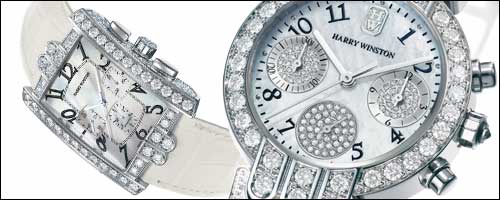Photo: The hidden faces of Harry Winston & Ronald Winston
The energetic and dynamic director of the Harry Winston watch division, Maximilian Büsser, sums up the meaning of this slogan, when he explains, "The concept of 'Rare Timepieces' is clear. Knowing that Harry Winston, the brand that cut 60 of the 300 largest diamonds of the planet, is known for its incredible and rare stones, it follows that the brand must also be known for its incredible and rare movements.”
The numbers seem to demonstrate that this strategy has worked. From US$ 8.6 million in turnover in 1999, the watch division reached US$ 32 million by the end of 2003. Between January and August 2003, this represents 23% more than the previous year, during bad economic times, and from September to December 2003, it is more than 31% higher than the previous year. So, how did Harry Winston arrive at these exceptional resultsı

Photo: AVENUE C CHRONOGRAPH
A rectangular 18 carat white gold watch set with 172 white diamonds. Automatic chronograph movement including hours, minutes and seconds, mother-of-pearl dial, sapphire crystal, crocodile strap with diamond-set white gold buckle, water-resistant to 30 metres.
LADY PREMIER CHRONOGRAPH
A round 18 carat white gold watch set with 35 diamonds. FP1270 meca-quartz chronograph movement including hours, minutes and seconds, diamond-set dial (86 white diamonds) sapphire crystal, white gold and rubber bracelet set with 90 diamonds, water-resistant to 30 metres.
Word-of-mouth
“Harry Winston watches are not yet very well known to the general public,” explains Maximilian Büsser, but this is not, for us, a reason to carry out intensive marketing campaigns. In the same manner as our jewellery division, we depend on word-of-mouth... and we create the necessary conditions so that this word-of-mouth is favourable.”
In the brand’s word-of-mouth strategy, one concept especially has made itself known, and that is the Opus series. A demonstration of transparency, the Opus operation has allowed the brand to first attract attention and then, to a greater and greater degree, stimulate the interest of the watch community and collectors. Each year, Harry Winston entrusts a remarkably talented watchmaker with the creation of an exceptional piece. In 2001, François-Paul Journe inaugurated the series with the Opus I. Then came Antoine Preziuso with the Opus II, followed by Vianney Halter with the Opus III, which also was the winner of Geneva’s Grand Prize of Watchmaking in 2003 in the technical section.
“That a brand originating in the world of jewellery could win Geneva’s Grand Prize of Watchmaking means that we have received incredible recognition, which validates our decision,” says Büsser. The Vianney Halter piece has what it takes to totally impress watch experts, not only with its retro-futuristic look, but also with its completely original mechanical-digital movement. Presented during Basel 2003, it was the most obvious ‘talking piece’ of the fair, providing Harry Winston with nearly universal media coverage.
Progressive verticalization
The example of the Opus must not let us forget that Harry Winston also offers innovative and technically very interesting watchmaking complications in all its various watch collections. From the standpoint of movements, a long-term collaboration has been established with one of the most talented watchmakers in Geneva, Jean-Marc Widerrecht d'Agenhor. Using mechanical calibres from Girard Perregaux and Piguet or quartz movements from ETA as a base, the watchmaker adds modules of complications such as the perpetual calendar, second time zone, off-centre display, bi-directional seconds, bi-retrograde indications, among others.
This sector represents about 20% of the Harry Winston watch production of a total of about 2,500 watches produced each year. The other 80% are diamond-set pieces intended primarily for the feminine market. Also remarkable is the progressive integration of the various watchmaking crafts into the Harry Winston production line-up. From eight people in 1998, the company now has 58 direct employees. As of the beginning of 2004, 60% of the cases are made in-house (by the 100%-owned subsidiary Hartech) and 75% of the dials are made in-house (by Les Cadraniers de Genève, which is 33% owned by Harry Winston).
Maximilian Büsser, trained at Jaeger-LeCoultre, does not want to remain simply at this level. Step by step, he intends for Harry Winston to become a real watchmaker. Even if not totally integrated, the goal is to sufficiently master production in order to proclaim its independence as its approaches its objective of 5,000 watches a year.
A very selective distribution
“Our distribution network is the limiting factor,” explains Büsser.” With 88 sales points around the world today, the network is very selective but is geographically balanced. In the United States, we have 31 sales points, which account for 21.4% of sales. In Europe, there are 16 sales points, providing 19.7% of our sales. Japan has 17 for 18.9%. The Middle East has 17, giving 21.7% while Asia has 13 for 16.3%.”
What also seems surprising is the decreasing age of the brand’s clientele, primarily explained by the marked creativity of the watch products. Women who like the brand are generally aged between 30 and 45, while men are between 30 and 50 years old.
“For our clientele, the price is not really important,” declares Büsser. It is a clientele that wants, above all, exclusivity and originality in their products.”






